Report on the support given by M Womersleys to Jabir Mohamed at Berbera Museum, Berbera, Somaliland, over two weeks from the end of October 2024

Contents
Introduction, Summary, The significance of the site, The importance of the work for Berbera’s built Heritage, The work required on-site to make the building safe and conserve its historic fabric, The progress made to complete emergency and permanent conservation works as of 13/11/24.
Introduction
M. Womersleys Ltd were asked to support Jabir Mohamed, owner of Raad Raac Studio, in his efforts to preserve Berbera’s built heritage. His work is vital to try and retain the characterful historic buildings which create charming, vibrant neighbourhoods in the old town and add delight and a real sense of history and place in other isolated pockets of the town, such as around the ‘Turkish Mosque’. The buildings north of this mosque, where Jabir began to focus his initial heritage training initiative, are now part of the Berbera Museum in Berbera, Somaliland. The first steps of this project are being supported by ‘The Queen Elizabeth II Platinum Jubilee Commonwealth Heritage Skills Training Programme funded by the Vinehill Trust’.
Mark Womersley was pleased to assist Jabir with preparing detailed repair specifications, sourcing and slaking the lime, providing training and guidance for workmen on site, lecturing and training undergraduate engineering students, suggesting emergency works and permanent repairs that could be carried out during this first visit, and working with him to prepare schedules for the necessary further repairs.
Summary
With further financial support from donors and NGOs, Jabir Mohamed's work can positively impact the conservation of Berbera’s built heritage. Mark Womersley would be honoured to give further support to this worthwhile project.
The significance of the site
The small Ottoman service building, upon which our work focused, appears to have originally been part of a complex of buildings linked to the ‘Turkish Mosque’, built in c.1840, together with the Ottoman Hall, a former library, school and community hall closely related to the Mosque. Please see Figures 1, and 3 to 13 below. The Ottomans had occupied Berbera from c.1801. The Ottoman Hall and its service building, which our initial work focused on, then came under the control of the British after they signed ‘protection’ treaties with several northern Somali clans to supply mutton for the Aden Garrison in the 1880s and took control of Berbera in 1884, following the withdrawal of the Ottoman Egyptian Garrison to fight the Mahist Rebellion in Sudan. Berbera was made capital of British Somaliland in 1888, until 1941, when the administration formally relocated to Hargeisa. Although after 1896, the British Somaliland Protectorate had Hargeisa as its main town until independence and the formation of the Somali Republic in 1960. Therefore, the British development of the site is likely to date between 1884 and 1896. During this period, the small Ottoman service building (Figures 2 and 14-18), upon which we began conservation work, may have been converted to a kitchen, with the introduction of the ventilation outlet through the roof and the insertion of new wooden doors

Figure 1. The location is within a complex of buildings, which the British Protectorate expanded after 1884

Figure 2.The small Ottoman building, October 2024
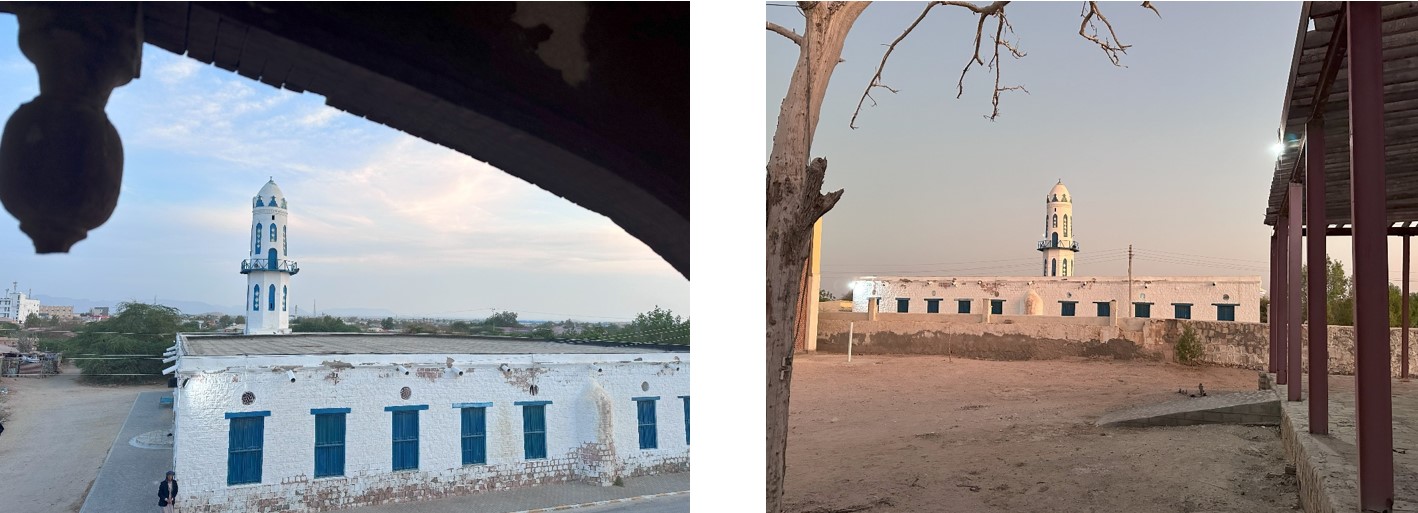
Figures 3 & 4. The ‘Turkish Mosque’ was built in 1840 and is directly connected to the former library and the small Ottoman building we are working on.

Figures 5 & 6. The minaret, the preaching chamber and the columned ‘Turkish Mosque’.

Figures 7- 10. The main entrance doors to the mosque show a hinge detail, a detail which was also found discarded on a wooden jamb in the small Ottoman building after the British added the later Victorian doors.

Figure 11. The Ottoman Hall, now Berbera Museum.

Figures 12 &13. The former Islamic school and library, the Ottoman Hall of the ‘Turkish Mosque,’ was serviced by the small Ottoman building before the British converted it into a club-reception space and the small building into a kitchen.

Figure 14.

Figure 15.

Figures 16 & 17.

Figures 18 & 19.
The importance of the work for conserving Berbera’s built Heritage
Developing conservation techniques appropriate to the local vernacular and Ottoman construction methods at the museum site will benefit the future conservation work in the historic early 19th-century Darole district of the old town of Berbera. Figures 20 to 37 below illustrate historic buildings' construction details, style, and decoration

Figures 20 & 21. Formerly owned by Goldsmiths, and now fish shops and a warehouse.

Figures 22 & 23. An Islamic Mausoleum and a Christian Church

Figures 24 & 25. Larger commercial buildings.

Figure 26. Mosque



Figures 27-31. Earlier Ottoman Construction from the 1840s had arched openings, arched central walls supporting lime roofs, and stone walls partly built with clay mortars and reinforced with longitudinal timbers.

Figures 32 & 33. In the older parts of Berbera, we find similar single-storey coral stone buildings to the one we are working on, with shallow-pitch solid roofs and numerous doorways onto the street.

Figures 34 & 35. Some with enriched cornice bands and ornate stuccowork.

Figures 36 & 37. Many were built between c.1801 and c1880.
The work required on-site to make the building safe and conserve its historic fabric.
Figures 98 to 101 and the schedule at the end of this report set out the emergency and permanent works required to conserve this small Ottoman building fully. The problems with the building fabric and the progress made in conserving it to date over the last two weeks are illustrated in Figures 39 to 97 below. The repair schedule is marked up to identify works still required in the next phase of works.

Figures 39 & 40. The roof, unmaintained for years, led to the breakdown of its surface coatings, allowing water ingress in the occasional wet spell.

Figures 41 & 42. Damp allowed termites to infest the 11 mm hardwood planks which held the roof above the roof joists, causing the roof to collapse into the rooms below.

Figures 43 & 44. This necessitated removing and storing the limestone roof to allow the eaten supporting timber planks to be discarded.
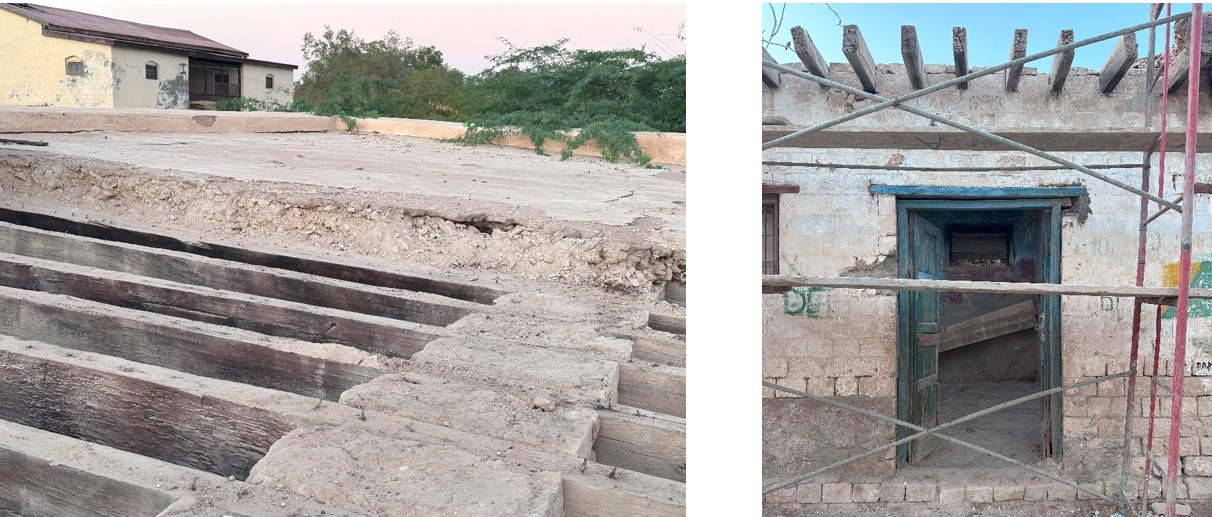
Figures 45 & 46. After the old roof covering was removed for just under half the roof area, the structure of the adjacent roof and the external wall detailing became visible.
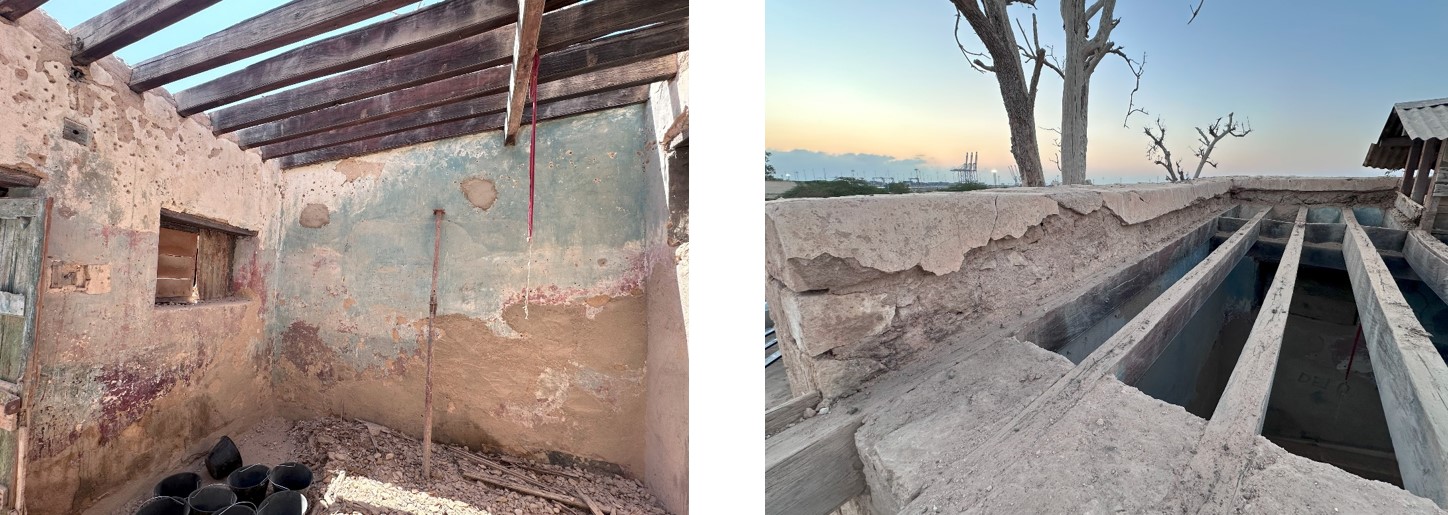
Figures 47 & 48. The remaining roof joists have some small areas of rot but appear sound enough to allow a new traditional roof to be installed upon them. The rendered parapet was also exposed and was patch-repaired with on-site slaked lime.
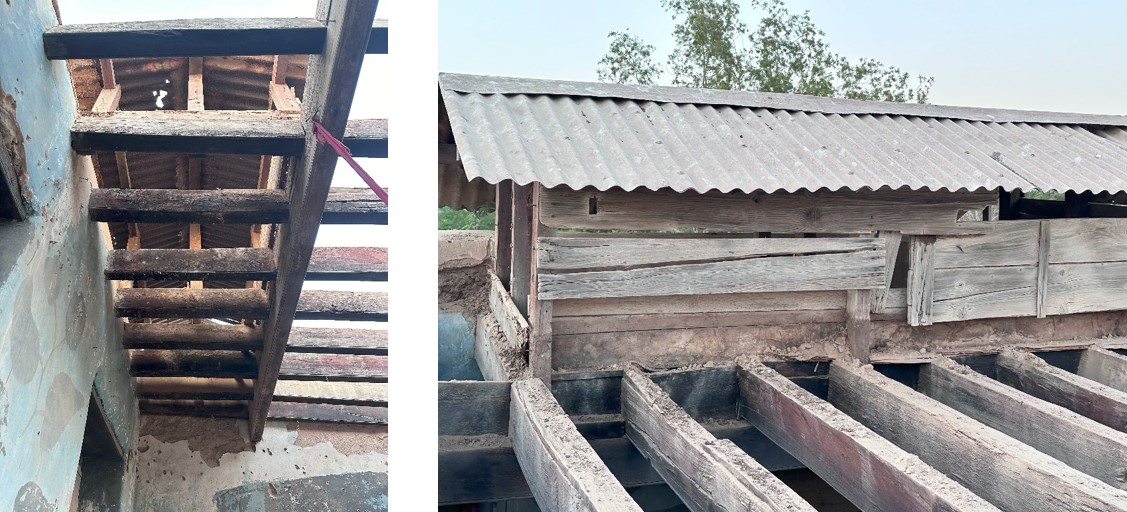
Figures 49 & 50. When this building became a kitchen, a natural ventilation system was introduced. Some facing timbers to the vent shaft had to be replaced, along with the rusted corrugated iron roof, but the main framework was in good condition and retained.
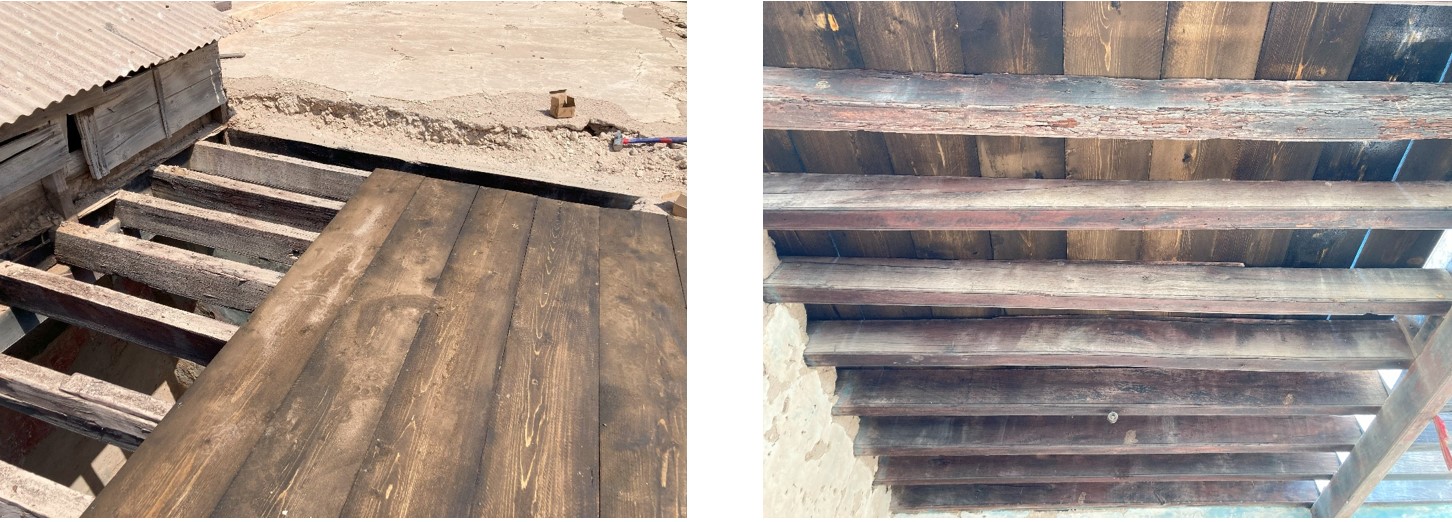
Figures 51 & 52. After initial delays in releasing money for our work, sourcing and purchasing thin hardwood timbers from another country, such as Yemen, within the time on site was impossible. Larger softwood planks that were locally available and had enough strength had to be used to reinstate a roof.

Figures 52 & 53. These planks were overlaid with approximately 60 mm of crushed, unburnt lime previously removed from the same roof. Over this stone base, an initial layer of slaked lime containing inert lime and charcoal was applied in one area. In another area, a mix of slaked lime with 10 mm down coarse local river sand from one of the temporary dry riverbeds in this area was applied. We want to see which appeared the easiest to use and test their respective durability and appropriateness as a base layer.

Figures 54 and 55. Over this base layer, an additional coat of slaked lime with 10 mm down coarse local river sand was applied. This was brought to temporary wooden shuttering at the roof's edge, as the original fascia board was missing except in isolated areas. The temporary shuttering was removed, a copied wooden fascia applied, and the mortar tidied up where it was on the back of the fascia.

Figures 56i, 56ii, & 57. Some of the slaked local lime was put through a fine mesh, and a lime wash was created, which was then applied to the roof surface as it dried out. Four coats will be applied, and they should be renewed with additional coats after each rainy season.

Figures 58-60. Collapsing stone walls, previously damaged when door frames were inserted, were rebuilt using matching coral stone found on site, bedded on a mix of one-part coarse lime putty to 1 part 4mm down river sand, and sieved down to this size on site.

Figures 61-63. In addition to rebuilding missing and collapsed stonework, large voids were filled with lime mortar and smaller pinning stones were used to fill the gaps and strengthen the walls.

Figures 64-66. Some voids had been filled with rubbish which was removed before rebuilding work.

Figures 67-68. Later, white cement and lime-based mixes were removed from the surface of some areas where they were loose or damaging the stone behind, and walls wet down were repointed with the same mix used for the building work.
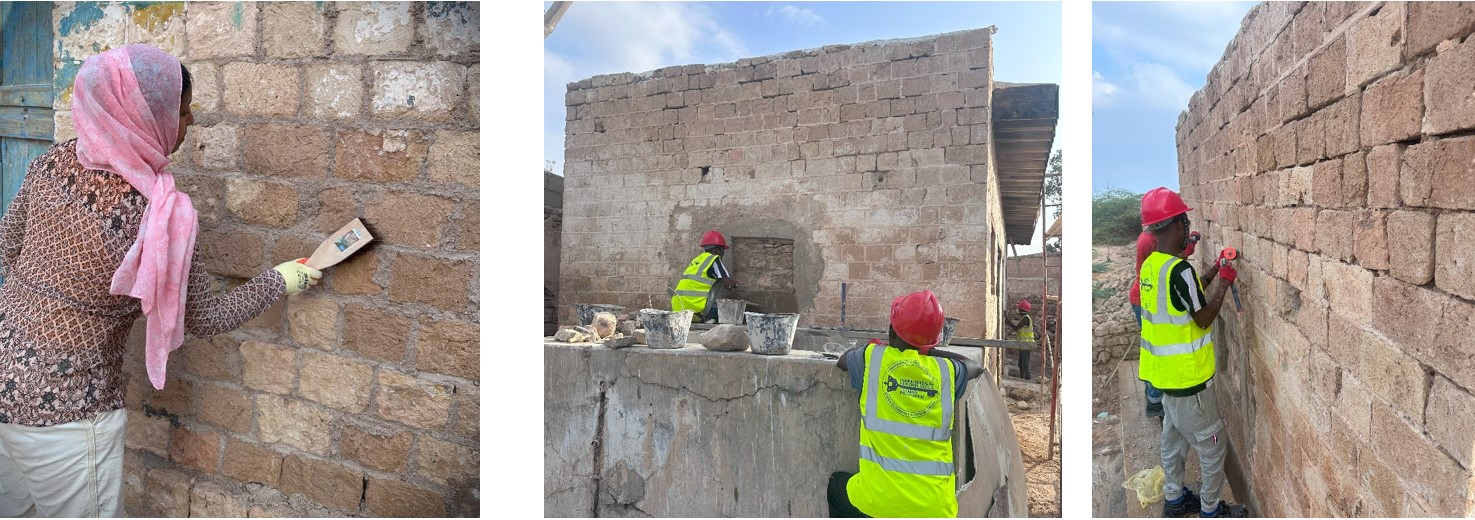
Figure 69. The mortar was stippled, brushed off, and dampened with buckets of water for 5 days after application to aid curing. Figures 70 & 71. The southwest return wall had a crudely inserted opening, causing the above wall to collapse. This former opening was built up tightly to prevent further collapse, and the whole elevation was repointed after removing later cement mortars.
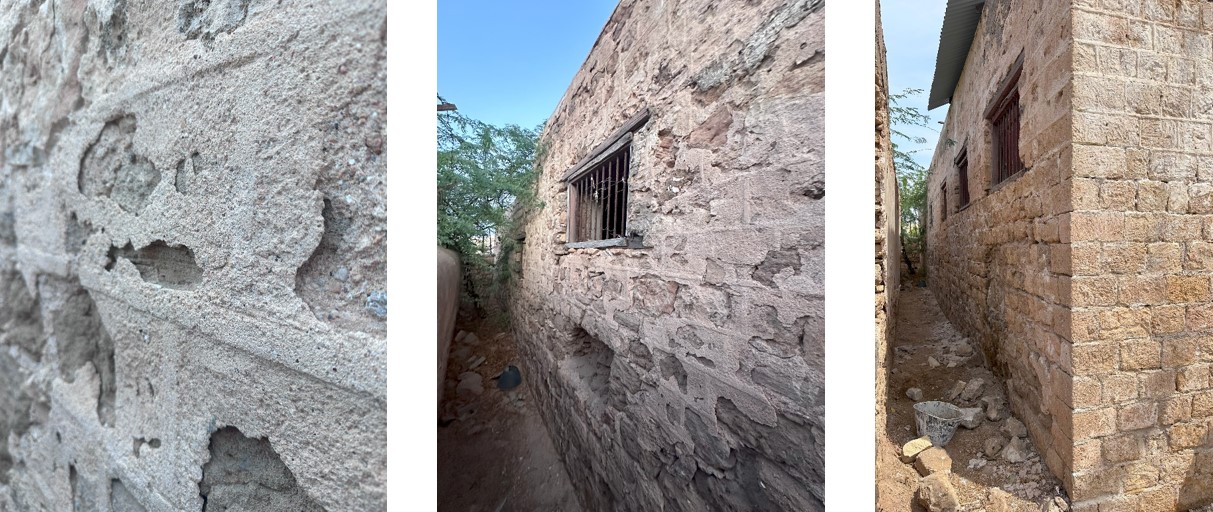
Figures 72-74. The rear wall is built of poorer quality stone, has had crude opening knocked in and had cement renders and pointing applied. The later mortars were removed, and the crude, structurally damaging openings were filled in with matching stone.

Figure 75. Later, modern paints and loose old lime washes were wire brushed off, ready for new limewash coatings. Figure 76. Mark and Jabir provided lectures to undergraduate engineers at the local Gollis University on using lime mortars, and a site visit and further education followed this up.

Figures 77-79. Doors were crudely inserted into old openings, perhaps during the late 1880s or 1890s. These doors now required conserving as they represent local craftsmanship, and the damaged stonework around the doors was repaired.

Figure 80. The right-hand door on the front elevation. Figures 81 and 82. Two doorways have been crudely inserted and then crudely filled between the rooms inside the building; these need to be made good and plastered.
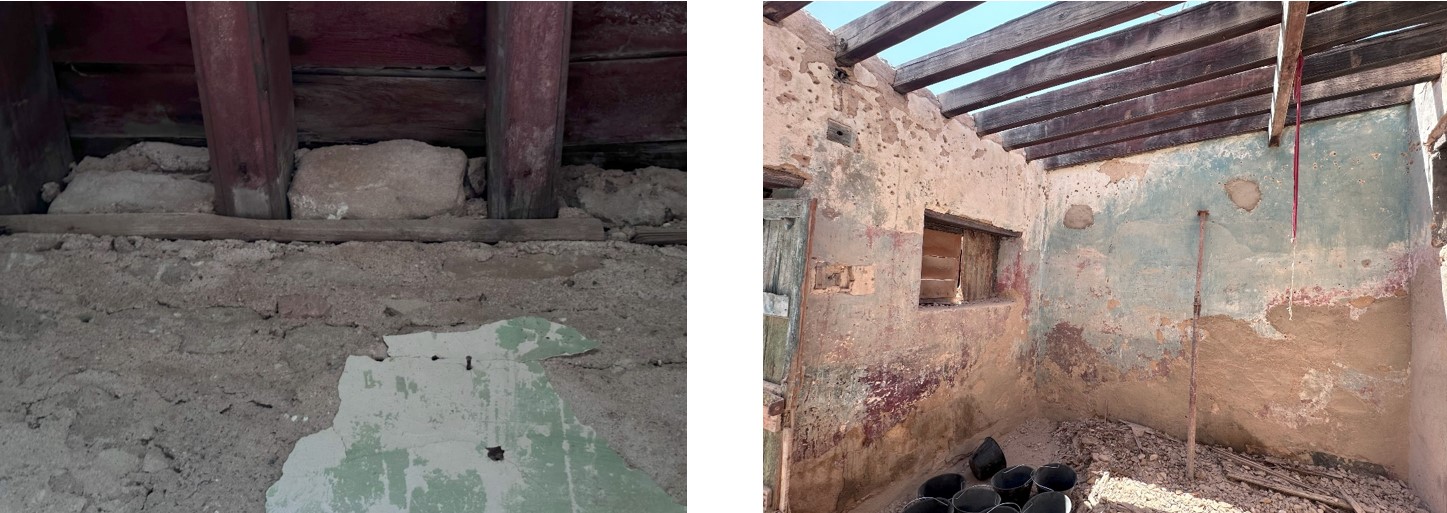

Figures 83-86. All the plaster on the walls has been replaced by weak cement mortars or is nearly completely de-bonded and needs removing before replastering with lime plaster. The base coats will be applied using the same mix applied to the roof, followed by a finer lime putty and fine-sieved sand mix for the topcoat.

Figures 87-89. The Guban Basin, situated within the Somaliland escarpment, is filled with up to three kilometres of Late Cretaceous and Cenozoic sedimentary rocks. In places within the basin, the Late Cretaceous Jesomma sandstone is overlain by the eroded remnants of the Eocene Taleh Anhydrite. The basin contains shale, limestone, mudstone, sandstone and evaporite. The limestone deposits in the Hargeisa area are primarily associated with Cretaceous and Tertiary geological formations, which suggest prolonged periods of marine sedimentation followed by uplift events related to the rifting of the East African Rift. Some of these limestone deposits were found at the quarry pictured and, in the google earth maps, above.

Figures 90-92. A lime burning pit was last used in the 1990s, with pockets of hydrated and air-slaked lime, iron-rich burnt stones, and charcoal from the burning process.

Figures 93 & 94. The partially slaked burnt lime used on the site was finally sourced from a second quarry north of Hargeisa, where lime was still burnt. The first illustration above shows the partial slaking to create a fine powder, which is then bagged up and ready for transport. The second shows bagging up in front of the wood and charcoal-fired kilns’ behind.

Photos 95-97. The semi-hydrated lime was slaked in metal baths we had made, for three days before being mixed with sieved local riverbed sand and mixed in a conventional large but fast concrete mixer.

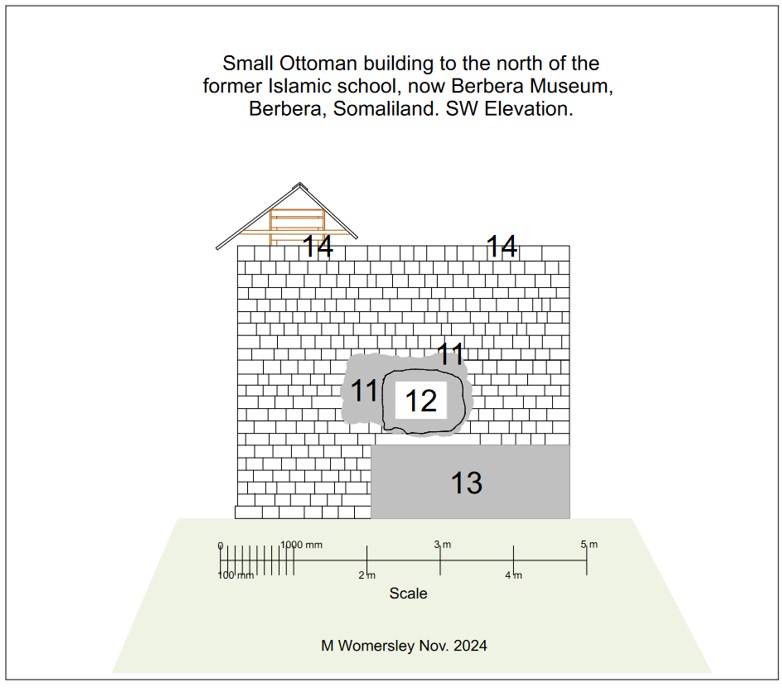
Figures 98 & 99: Proposed works required to make the building structurally sound and weather-tight, to remove later damaging interventions and conserve the remaining fabric. The numbered references are detailed in the following repair schedule.

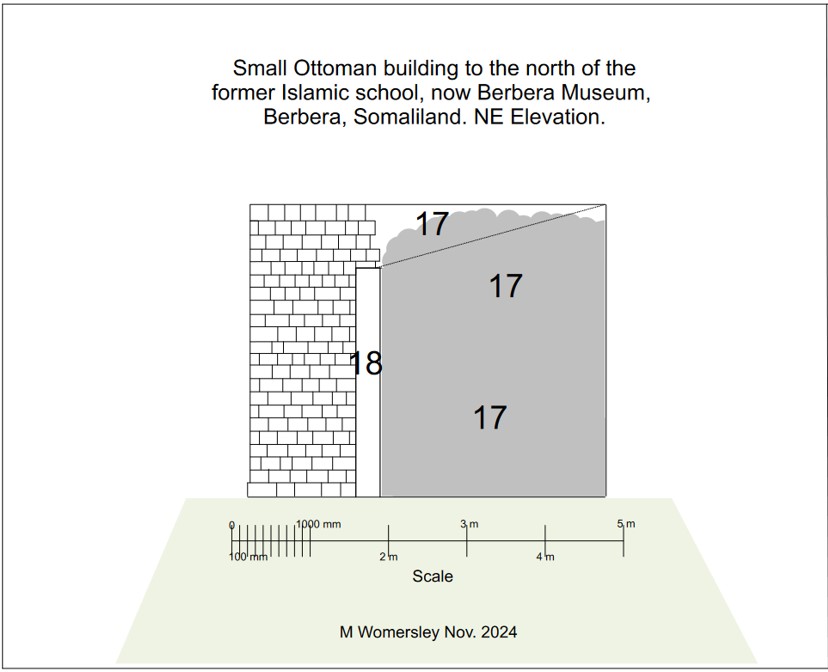
Figures 100 & 101: Proposed works required to make the building structurally sound and weather-tight, to remove later damaging interventions and conserve the remaining fabric. The numbered references are detailed in the following repair schedule.
A schedule of emergency and permanent conservation works that are required for the small Ottoman building, Berbera Museum, Berbera.
1. Remove existing termite-damaged planks that no longer support the collapsing roof. The roof above the planks comprises 120 mm of crushed hardcore limestone, 20 mm of purer lime render finish, and layers of lime wash. = 40% complete
2. Replace the damaged timberwork of the later vented opening and its rusted corrugated iron sheet roof.= Completed
3. Replace the missing fretwork fascia board to match the existing one. = Completed &repair and conserve the existing fascia board
4. Repair the doors, replace missing styles, and brace from the rear to allow retention of as much of the original fabric as possible, and replace missing curved decorative brace-work.
5. Remove later cementitious external render that is damaging the stone beneath. = Completed
6. Repair small patches of collapsing stonework.= 70% completed
7. Repair cracking masonry after rebuilding work below.
8. Rebuild the lost area of the parapet top and render over the edge by approximately 50-70 mm. = 50% completed
9. Rebuild the damaged plinth that forms the threshold for the door. = Completed
10. Repair the cracked water tank and patch the render with a cementitious render to match the existing.
11. Remove later cementitious render that is damaging the stone beneath.= 50% completed
12. Block this later opening, which is already blocked on the inside, and apply lime render to the later cement surround.= Completed
13. Repair the cracked water tank and patch the render with a cementitious render to match the existing.
14. Rebuild the lost area of the parapet top and render over the edge by approximately 50-70 mm.
15. Build up the crudely left openings in the outer leaf.= 50% completed
16. Remove cement render and repair, rebuild small areas and repoint the damaged random rubble stonework.
17. Remove cement render and repair, rebuild small areas and repoint the damaged random rubble stonework.
18. Reduce the current wall to a 500 mm stub wall-pier.
19. To all coursed stonework, remove later pointing and repoint in local slaked lime and sand.= 30% completed
20. Treat all projecting ceiling/roof rafters with wood protection.
21. Limewash the whole building with two coats of lime wash.
22. Fully block the two openings between rooms and plaster.
23. Remove all de-bonded lime plaster and late cement plasters and re-plaster with three-coat lime plaster.
24. Paint all interior finishes with lime wash and treat all exposed wood with plant and tree resin-based finishes.
Related Articles
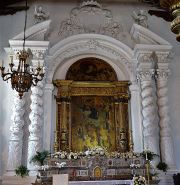
On Sunday, March 16th, why not come for a full introduction to lime plastering and a practical demonstration workshop?
Learn more about traditional clay, lime, and ornamental gypsum plasters and their use internationally…
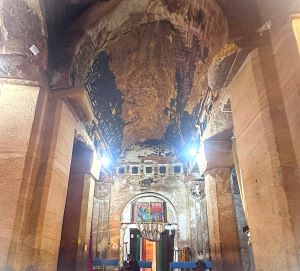
Proposals to carry out a conservation assessment at Wukro Cherkos, with a full training programme for recent graduates from Mekelle University and government bodies responsible for regional conservation work.
Introduction In response to continued concerns about the condition of one of Tigray’s most well…

Analysis of Building Mortars from the Famous Lister Mill Chimney in Bradford
M. Womersleys has recently completed a mortar analysis of several samples collected from the iconic …